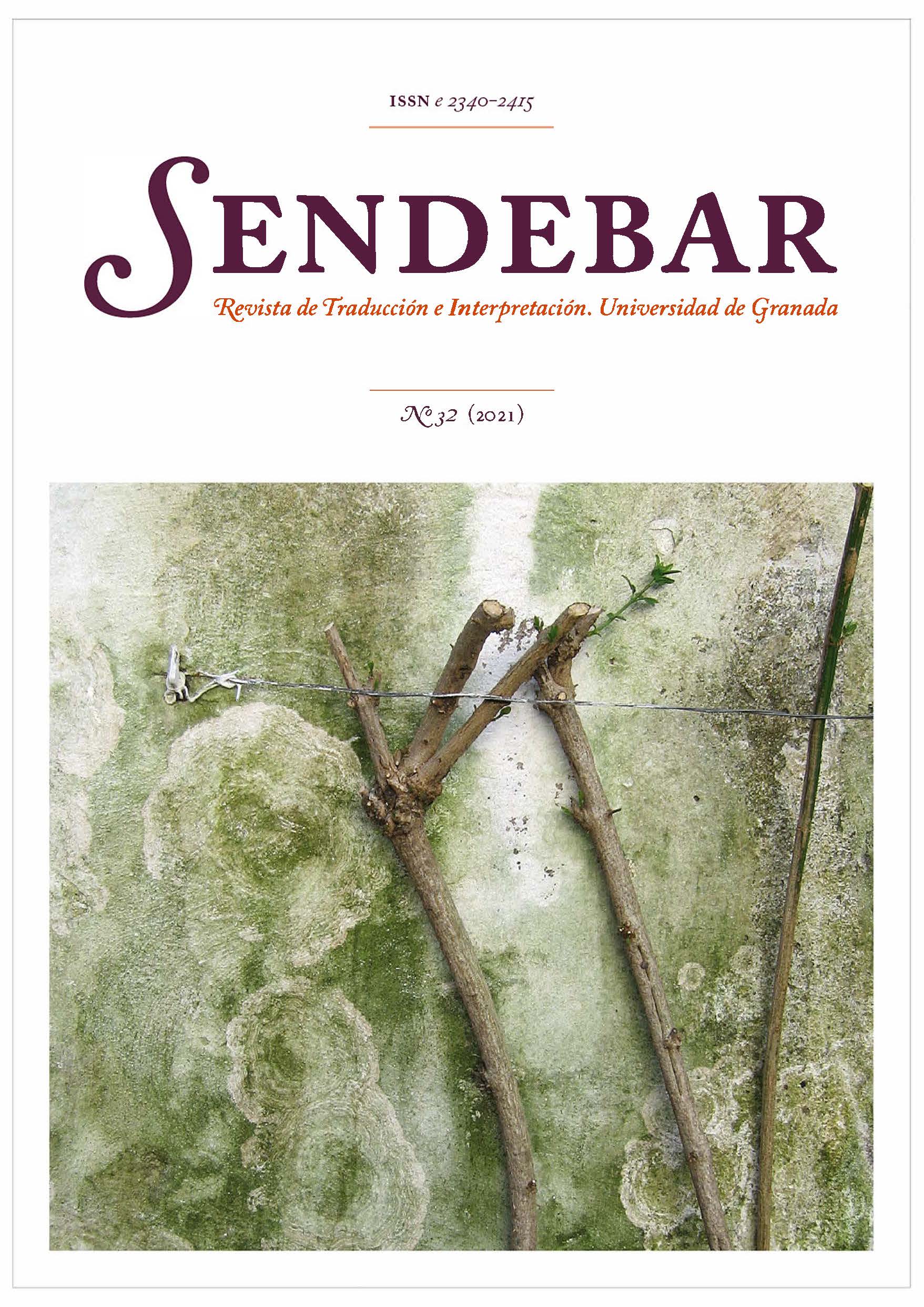Interpreting Verbal Humor. A Functionalist Approach
DOI:
https://doi.org/10.30827/sendebar.v32.13499Keywords:
verbal humor, interpretation, functionalism, methods and techniquesAbstract
From the perspective of functionalism, this article explores the specific methods and techniques of interpretation of verbal humor (from Spanish to Chinese, or vice versa) in order to achieve the goal of fluent communication. Therefore, we analyze the main standards of functionalist translation. According to these principles and specific examples of interpretation, we propose three methods of interpretation and their respective techniques: (a) Literal interpretation: the correspondence between the original text and the target text is achieved in form, content and function. (b) Free interpretation: the content and function are properly modified and retained. The specific techniques are amplification, compensation, enhancement and elision. (c) Interpretation and communication: the functions are maintained. The respective technique is partial replacement.
Downloads
References
Apte, M. L. (1985). Humor and laughter: An anthropological approach. Cornell University Press.
Asscher, O. (2010). A model for Hebrew translation of British humor: Amplification and overstatement. Target: International Journal on Translation Studies, 22(2), 237-263.
Attardo, S. y Raskin, V. (1991). Script theory revisited: Joke similarity and joke representation model. Humor: International Journal of Humor Research, 4(3/4), 347–411.
Attardo, S. (1994). Linguistic theories of humor. Mouton de Gruyter.
Attardo, S., Hempelmann, C. y DiMaio, S. (2002). Script Oppositions and Logical Mechanisms: Modeling Incongruities and their Resolutions. Humor: International Journal of Humor Research, 15(1): 3-46.
Chan, Y. y Lavallee, J. P. (2015). Temporo-parietal and fronto-parietal lobe contributions to theory of mind and executive control: an fMRI study of verbal jokes. Frontiers in Psychology, (6), 1285.
Chen, H., Chan, Y., Dai, R., Liao, Y., Tu, C. (2017). Neurolinguistics of Humor en S. Attardo (Ed.), The Routledge Handbook of Language and Humor. Routledge.
Chen, Y., Wang, W. (2020). Translating English humor into Chinese subtitles: a semiotic perspective. Perspectives, 1-17.
Chiaro, D. (1992). The Language of Jokes: Analyzing Verbal Play. Routledge.
Chiaro, D. (2005). Foreword. Verbally Expressed Humor and Translation: An Overview of a Neglected Field. Humor: International Journal of Humor Research, 18(2): 135-145.
Chiaro, D. (2006). Verbally expressed humour on screen: Reflections on translation and reception. The Journal of Specialized Translation, (6), 198-207.
Chiaro, D. (2017). Humor and translation en S. Attardo (Ed.), The Routledge Handbook of Language and Humor. Routledge.
Delabastita, D. (1993). There´s a double tongue: An investigation into the translation of Shakespeare´s Wordplay, with special reference to Hamlet. Rodopi.
Figueroa-Dorrego, J. y Larkin-Galiñanes, C. (2009). A source book of literary and philosophical writings about humour and laughter. Edwin Mellen.
García-Yebra, V. (1989). Teoría y Práctica de la Traducción. Gredos.
Gómez-Capuz, J. (2002). Mecanismos del Lenguaje Humorístico. Oralia: Análisis del Discurso Oral, (5), 75-101.
Hirsch, G. (2011). Explicitations and other types of shifts in the translation of irony and humor. Target: International Journal of Translation Studies, 23(2): 178-205.
Hurtado-Albir, A. (2004). Traducción y traductología. Cátedra.
Jáuregui, E. (2008). Universalidad y variabilidad cultural de la risa y el humor. AIBR: Revista de Antropología Iberoamericana, 3(1), 46-63.
Lefcourt, H. M. (2001). Humor: The psychology of living buoyantly. Kluwer Academic.
Leibold, A. (1989). The translation of humor; who says it can´t be done? Meta: Translator´s Journal, (1), 109-111.
Nash, W. (1985). The language of humor. Longman.
Nord, C. (1991). Scopos, loyalty and translational conventions. Target: International Journal on Translation Studies, 3(1), 91-101.
Nord, C. (2005). Translation as a purposeful activity: Functionalist approaches explained. Foreign Language Teaching and Research Press.
Norrick, N. R. (2007). Interdiscourse humor: Contrast, merging, accommodation. Humor: International Journal of Humor Research, 20(4), 389-413.
Popa, D. (2005). Jokes and Translation. Perspectives: Studies in Translatology. (1), 48-57.
Raphaelson-West, D. (1989). On the Feasibility and Strategies of Translating Humor. Meta: Translator´s Journal, (1), 128-141.
Redfern, W. (1984). Puns. Blackwell.
Reiss, K. y Vermeer, H. (1996). Fundamentos para una teoría funcional de la traducción. Akal.
Reiss, K. (2004). Translation criticism—the potentials & limitations. Shanghai Foreign Language Education Press.
Shih, T. (2006). Estudio sobre la traducción del humor audiovisual en chino y español. Desde una perspectiva cultural. [Tesis de Maestría, Universidad Autónoma de Barcelona]
Tolosa-Igualada, M. (2006). De la traducibilidad del chiste, más allá de los factores perceptibles. Interlingüística (16), 1079-1089.
Tsai, C. (2015). Reframing humor in TV news translation. Perspectives, 23(4):615-633.
Vandaele, J. (1995). Describing translated humour in comedy. CETRA.
Vandaele, J. (2002). Translating humour. Routledge.
Vandaele, J. (2002). Funny fictions: Francoist translation censorship of two Billy Wilder Films. The Translator, 8(2), 267-302.
Valbuena de la Fuente, F. (2002). Humor verbal y humor de situación. Cuadernos de Información y Comunicación, (7), 381-406.
Williamson, L. y Ricoy, R. (2014). The translation of wordplay in interlingual subtitling. A study of Bienvenue chez les Chi’tis and its English subtitles. Babel, 60(2), 164-192.
Yus, F. (2017). Relevance-theoretic treatments of humor en S. Attardo (Ed.), The Routledge Handbook of Language and Humor. Routledge.
Zabalbeascoa P. (1996). Translating jokes for dubbed television situation comedies. The Translator, 2(2), 235-257.
Zabalbeascoa, P. (2005). Humor and Translation- an Interdiscipline. Humor: International Journal of Humor Research,18(2), 185-207.
Downloads
Published
How to Cite
Issue
Section
License
Terminos de Licencia Sendebar.

















